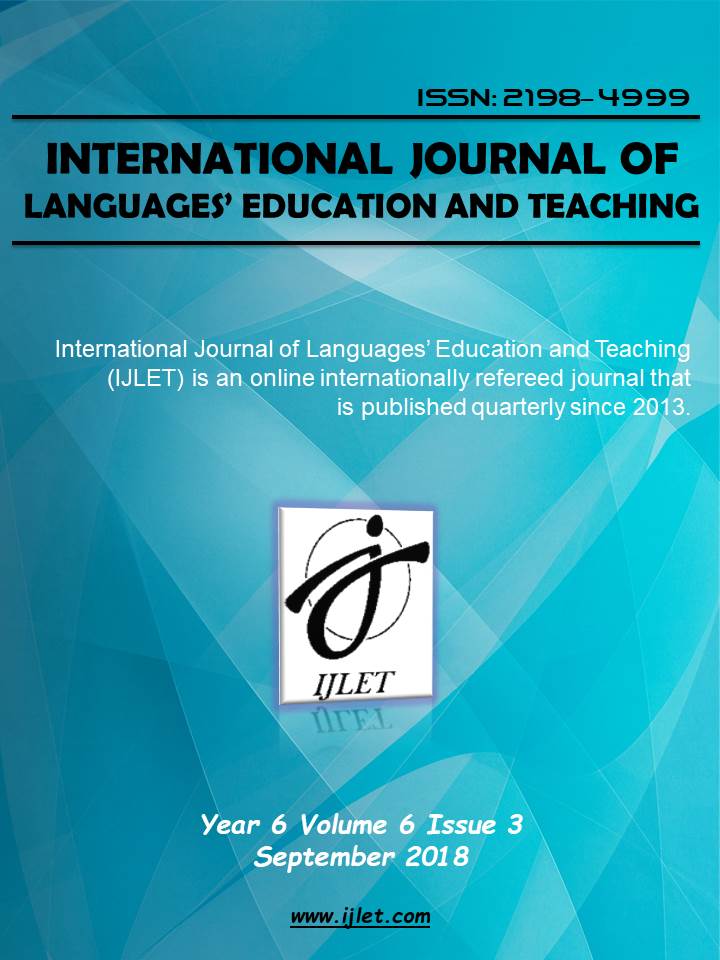Author :
Abstract
Keywords
Abstract
Grit, which is defined as the tendency to sustain interest in and effort toward very long-term goals, has become a central phenomenon in recent educational research. Grit provides learners with perseverance to master their skills and become more competent. Developing grit is as significant as developing their cognitive strategies and skills. Grit has a large impact on academic achievement. This study aims to explore how grit relates to the academic success of different English as a foreign language learner (EFL) populations in a college context. The study provides data regarding the participants’ levels of grit as well as whether their levels of grit have a relation with students’ achievement scores. Plus, participants’ characteristics along with their goals will be revealed in relation to their grit levels. The data analysis revealed striking results on grit which is an under-researched concept in the English language teaching contexts and its impact on the language learning process.
Keywords
- Bazelais, P., Lemay, D.J., and Doleck, T. (2016). How does grit impact college students’ academic achievement in science? European Journal of Science and Mathematics Education, 4(1), 33‐43.
- Changlek, A., and Palanukulwong, T. (2015). Motivation and grit: Predictors of language learning achievement. Veridian E-Journal, 8(4), 23-38.
- Cook, V. (2001). Second language learning and language teaching (3rd ed.). New York: Oxford University Press, Inc.
- Creswell, J. W. (2014). Research design: Qualitative, quantitative, and mixed Methods Approaches. London: Sage Publications, Inc.
- Cross, T. M. (2014). The Gritty: Grit and non-traditional doctoral student success. Journal of Educators Online, 11(3), 1-30.
- Dörnyei, Z. (2007). Research methods in applied linguistics. New York: Oxford University Press.
- Duckworth, A. L., Peterson, C., Matthews, M. D., and Kelly, D. R. (2007). Grit: Perseverance and passion for long-term goals. Journal of Personality and Social Psychology, 92(6), 1087-1101.
- Duckworth, A. L., and Quinn, P. D. (2009). Development and validation of the Short Grit Scale (Grit- S). Journal of Personality Assessment, 91, 166-174.
- Duckworth, A. L. (2013, April). The key to success? Grit [Video File]. Retrieved November 1, 2017, from Ted Talks Education: http://www.ted.com/talks/angela_lee_duckworth_the_key_to_success_grit?language=en
- Duckworth, A. L., and Gross., J. J. (2014). Self-control and grit: Related but separable determinants of success. Current Directions in Psychological Science, 23 (5), 319-325.
- Duckworth, A. (2016). Grit: The power of passion and perseverance. New York: Scribner.
- Dyer, J. (2016). Discovering grit: Getting gritty about making students grittier (Unpublished Master’s Thesis). Vancouver Island University. Canada.
- Ellis, R. (2008). The study of second language education. (2nd ed.) Oxford: Oxford University Press.
- Focus: Grit. (2014, April 1). Retrieved on November 3, 2017 from http://wssda.org/Portals/0/News/Research Blast/WSSDA Research Blast May 2014.pdf
- Furnham, A., Nuygards, S., & Chamorro-Premuzic, T. (2013). Personality, assessment methods and academic performance. Instructional Science, 41(5), 975-987.
- Gray, J. P., and Mannahan, K. K. (2017). How well do trait measures of achievement predict students’ perceptions of the link between personal effort and academic performance. The Journal of Effective Teaching, 17 (1), 16-27.
- Horn, M. (2013). Building motivation, instilling grit: The necessity of mastery-based, digital learning. Leadership, 1-2.
- https://www.forbes.com/sites/margaretperlis/2013/10/29/5-characteristics-of-grit-what-it-is-why-you- need-it-and-do-you-have-it/
- http://wssda.org/Portals/0/News/Research%20Blast/WSSDA%20Research%20Blast%20May%202014.p df
- Keegan, K. (2017). Identifying and building grit in language learners. English Teaching Forum, 55(3), 2- 9.
- Oxford, R., and Shearin, J. (1994). Language learning motivation: Expanding the theoretical framework. Modern Language Journal, 78(1), 12-28.
- Paff, L. (2016, November). Enhancing learning through zest, grit, and sweat. [Online Article]. Retrieved November 19, 2017, from https://www.facultyfocus.com/articles/course-designideas/enhancing-learning-zest-grit-sweat/
- Richards, J. (2009). Interviews. In J. Heigham & R. A. Croker (Eds.) Qualitative research in applied linguistics: A practical introduction (pp. 182-200). London: Palgrave Macmillan.
- Robert, Y. (2009). Grit: The skills for success and how they are grown. London: The Young Foundation.
- Shechtman, N., DeBarger, A. H., Dornsife, C., Rosier, S., and Yarnall, L. (2013). Promoting grit, tenacity, and perseverance: Critical factors for success in the 21st Century. Retrieved from http://pgbovine.net/OET-Draft-Grit-Report-2-17-13.pdf on November 25, 2017.
- U. S. Department of Education. (2013). Promoting grit, tenacity, and perseverance: Critical factors for success in the 21st century. Washington, DC: Author.
- Von Culin, K., Tsukayma, E., and Duckworth, A. (2014). Unpacking grit: Motivational correlates of perseverance and passion for long-term goals. Journal of Positive Psychology, 9(4), 306-312.
